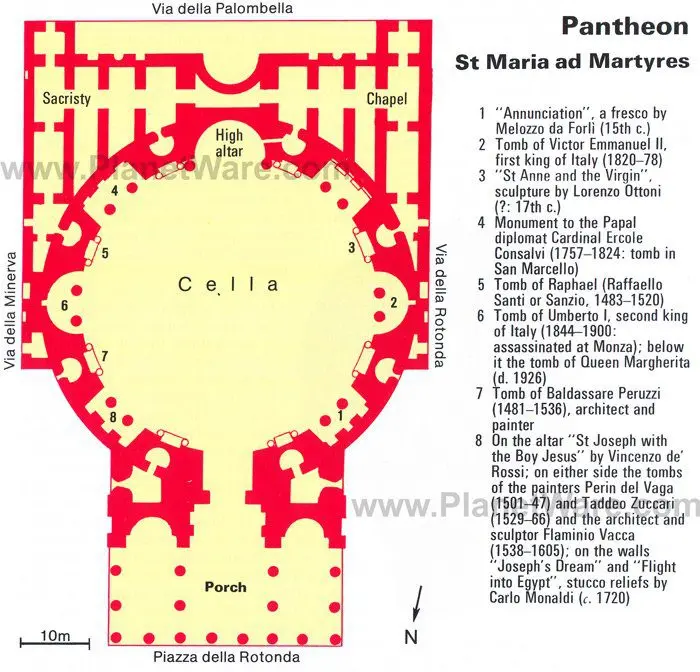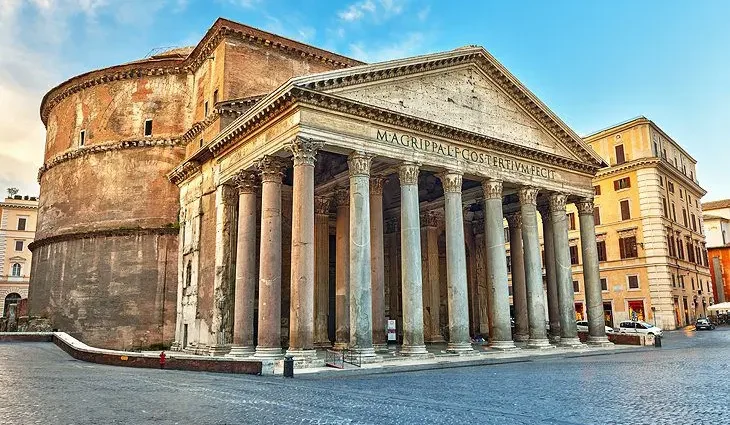Contents
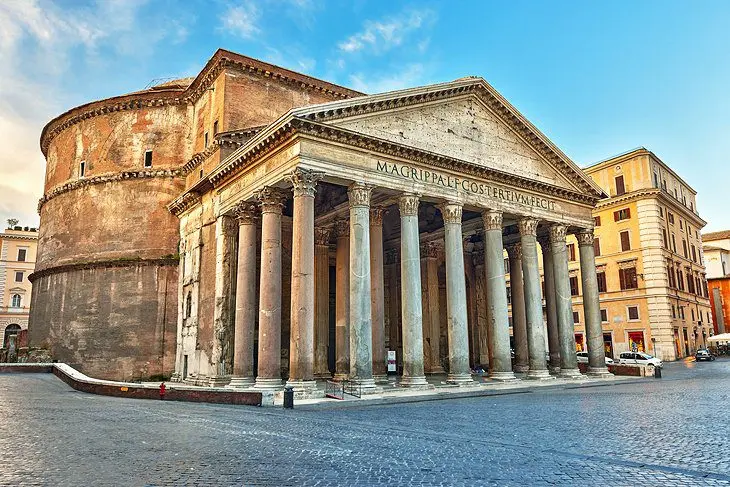
The survival of Rome’s most complete ancient structure for two millennia is largely due to its architecture. The Pantheon is so well designed–and so simple–that it is still almost entirely intact. This is all the more amazing when you consider that two different popes had its roof metal removed for other uses, leaving it unprotected for centuries. Its age, condition, and the beauty of its form make it one of the most popular tourist attractions in Rome, and it is included in tours of the city’s ancient sites.
Built by Marcus Agrippa, son-in-law of the Emperor Augustus, the temple was dedicated to the most holy planetary gods, with the dome representing the firmament, and its opening representing the sun. Damaged by fire in AD 80, it was rebuilt in the reign of Hadrian (AD 120-125); the brickwork of this period demonstrates the technical mastery achieved by the Romans.
Early Christian emperors forbade using this pagan temple for worship, and it was disused until Pope Boniface IV consecrated it as a Christian church and dedicated it to the Virgin and all the Christian martyrs on November 1 in 609–the origin of the Christian feast of All Saints.
The great dome rests on a cylinder of masonry walls, inside which are large, empty spaces. These voids, combined with the alcoves that surround its interior, allow for a lighter construction, while supporting the dome through strong arches.
The visual effect is that of three continuous arcades, and if you look at the rotunda from the outside, you can see the brick arches that absorbed some of the stress from the dome’s weight. Originally, these exterior walls were faced with fine marble, but over the centuries it has been removed.
Dome
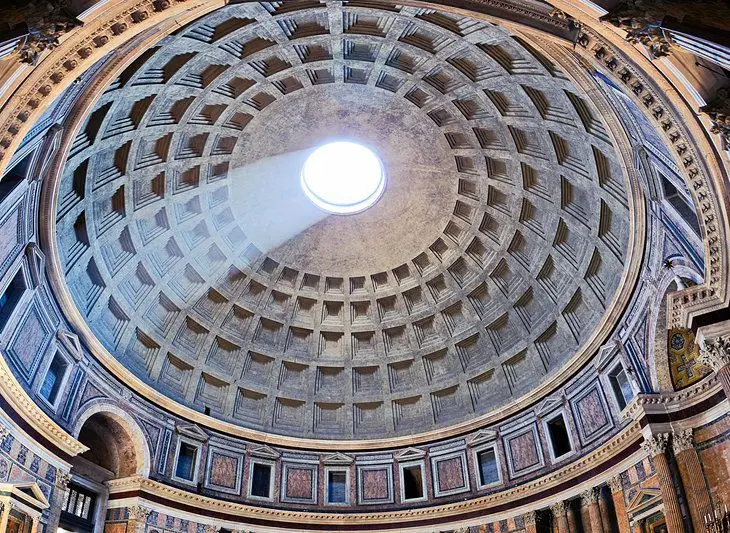
Still the world’s largest unreinforced solid concrete dome, the Pantheon inspired Brunelleschi’s dome for the Renaissance Cathedral in Florence, Bramante’s design for St. Peter’s Basilica, and the US Capitol, making it one of the most influential buildings in western architecture.
The builders solved the problem of the dome’s weight by changing the stone that was used in making the concrete, using lighter stone for each layer as it rose. The two top bands were mixed with tufa and pumice, respectively. Viewed from the Piazza della Rotonda, where the Pantheon is seen hemmed in by buildings, the dome appears much flatter than it really is, so its full effect is best appreciated from the inside.
The interior of the dome is coffered, and the nine-meter circular opening at its center, the oculus, is the building’s only source of light. Because it remains open, the floor is sloped gently outward to allow for rainwater runoff. The original gilded bronze roof tiles were removed by order of Pope Gregory III, while Urban VIII used the heavy bronze roofing of the porch for construction of Bernini’s baldacchino in St. Peter’s Basilica.
Porch
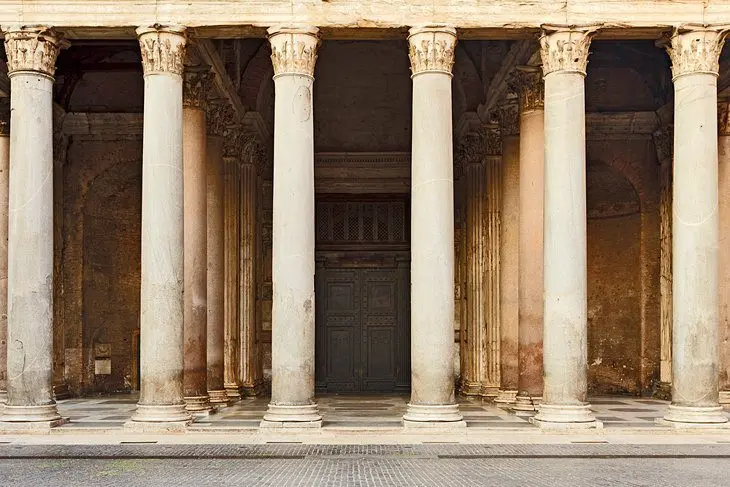
Originally steps lead up to the Pantheon’s entrance, but the ground level has risen considerably in 2,000 years, and steps now lead down into the porch. Its 33-meter width is surrounded by 16 granite columns with Corinthian capitals.
Although the building was reconstructed after the fire in AD 80, an inscription that was on the original Pantheon was added above the porch of the new Pantheon. It reads: “M·AGRIPPA·L·F·COS·TERTIUM·FECIT” (Marcus Agrippa, son of Lucius, consul for the third time, built this.) The bronze doors, which were originally covered in gold, weigh 20 tons each and fortunately escaped melting down by later popes, as happened to the bronze roof.
Interior
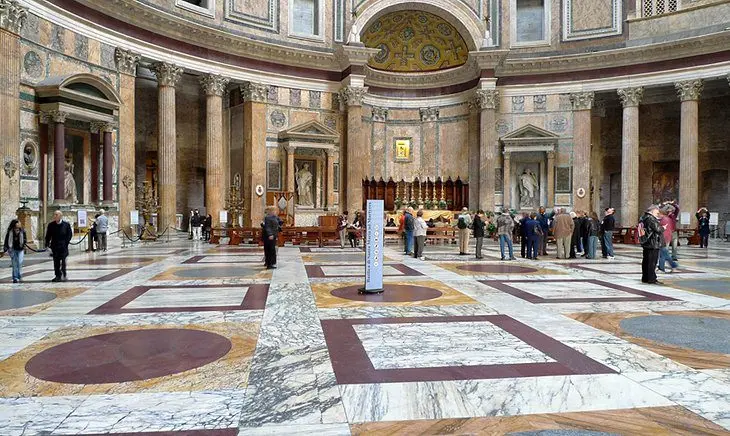
The mighty dome of the Pantheon was the supreme achievement of Roman interior architecture, but the overwhelming effect of the interior is because of the whole vast structure’s harmonious proportions. The height – 43.2 meters — is the same as the diameter, while the height of the cylinder that supports the dome is half the diameter.
Set into the walls, which are 6.2 meters thick, are semicircular and rectangular niches that not only vary it visually, but also lighten its bulk. The restrained decoration enhances the effect of the architecture. The harmony and perfect proportions, based on the image of the earth with the vault of the firmament above it – are as impressive today as they were 2,000 years ago.
Tombs and Art
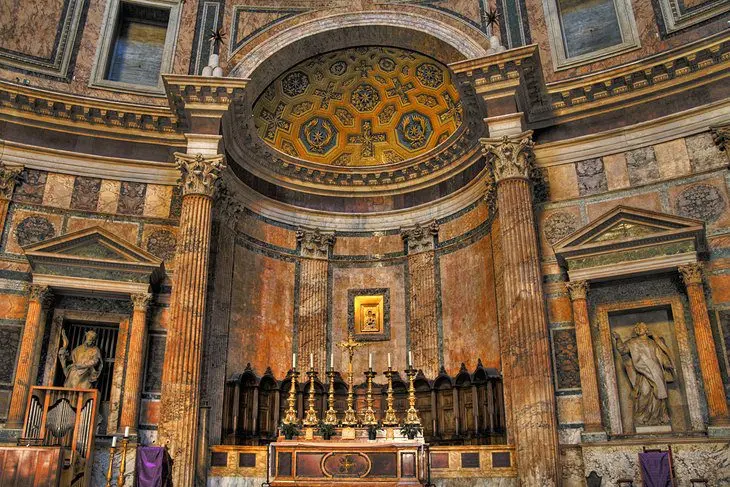
The Pantheon is the place of burial of the Italian kings, Victor Emmanuel II in the second niche on the right and Umberto I and his wife Queen Margherita in the second niche on left. The great Cardinal Secretary of State Consalvi is memorialized in a monument created in 1824 by the Danish sculptor Bertel Thorvaldsen, in the third niche on the left.
The tomb of Renaissance painter Raphael is between the second and third niches on the left. The first niche on the left has the tombs of 16th-century painters Perin del Vaga and Taddeo Zuccari and sculptor/architect Flaminio Vacca. The stucco reliefs on the walls of that niche are by 18th-century artist Carlo Monaldi. The first niche to the right of the entrance has a 15th-century fresco, The Annunciation, by Melozzo da Forli.
Above the main altar, directly opposite the entrance, is an original 7th-century icon of the Madonna and Child, recovered under later layers of paint. This is one of the rare surviving icons that were common in Roman churches of that period. Above the icon, the half-dome of the apse is covered in gold mosaic of cross designs. In a niche to the right, you can see fragments of decoration from the second century.
Tips and Tactics: How to Make the Most of Your Visit to the Pantheon
- Visiting the Pantheon on Your Own: This is one of the top tourist attractions in the city, so it can get crowded in the summer. For a better chance of seeing it without crowds, plan to go early in the morning (it opens at 8:30am) or late. It stays open until 7:30pm and until 6pm on Sunday. Admission is free.
- Photographing the Pantheon: The best light is around noon, when the sun shines through the oculus. The most dramatic view in the Pantheon is taken from directly beneath the oculus, aiming straight up. Don’t try this on a rainy day!
- For Your Safety: On rainy days be careful of the floor, which can be slippery when it’s wet.
Getting to the Pantheon
- The streets of this part of ancient Rome are too narrow for buses, but the hop-on-hop-off sightseeing buses all stop within a short walk of Piazza della Rotonda, between it and Piazza Navona.
- There is no nearby Metro station, but Piazza Argentina is a stop for the frequent 40, 60, and 64 buses running between the Vatican, the city center, and Termini railway station.
Address
- Piazza della Rotonda, Rome
Where to Stay near the Pantheon

There is no escaping the fact that hotels in Rome are among the most expensive in Italy. Some of the best-value lodging options in Rome are fully serviced rooms without a formal reception desk; your host meets you on arrival, and you come and go with your own key. Don’t overlook these and modest B&Bs when looking for lodging at a reasonable rate. We recommend these hotels either overlooking the Pantheon or a short stroll away:
- The four-star boutique Martis Palace Hotel Rome is in a Neoclassical building with a rooftop deck, a few steps from Piazza Navona.
- Best Suites Pantheon offers more simple rooms in Piazza della Rotonda, opposite the Pantheon, with a café breakfast, an excellent value in a prime location.
- Lavishly decorated guest rooms at the Boutique Hotel Campo de Fiori have balconies overlooking this charming neighborhood, and there’s a rooftop terrace.
- Residenza Maritti is a few blocks farther from the Pantheon, but its reasonable rates make it worth a little walk. There is a rooftop terrace, a guest kitchen, and the buffet breakfast is included.
Attractions near the Pantheon
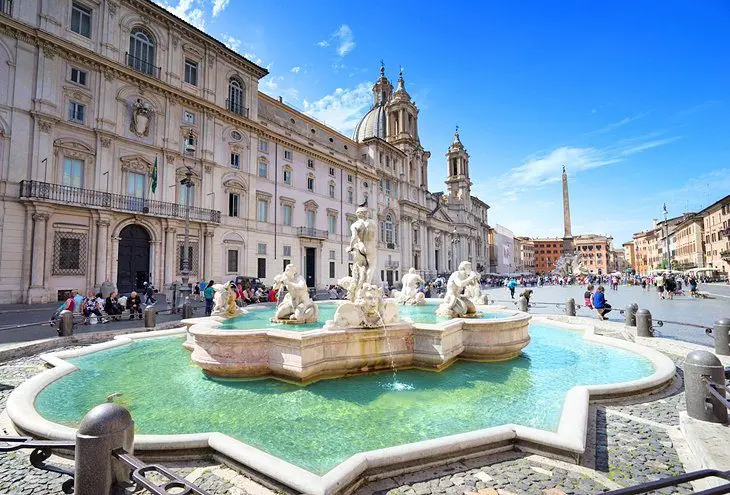
The Pantheon is located in one of Rome’s most picturesque and interesting neighborhoods, and is within a five-minute walk of two of the city’s favorite piazzas: Piazza Navona and the charming Campo de’ Fiori with its colorful market.
About the same distance in the opposite direction is the famous Trevi Fountain; no tourist should leave the city without a nod to this tradition from the days of ancient Rome, when Romans threw a coin in the fountain to assure a safe return.
Before you leave Piazza della Rotonda, walk behind the Pantheon to the Piazza della Minerva to discover an obelisk balanced on the back of an elephant sculpted by Bernini. Look here for the tiny Via del Pie’ di Marmo to find a surprising sight. A huge foot carved in marble and wearing a sandal stands on a pedestal, all that remains of a gigantic statue of the Egyptian goddess Isis, much revered by ancient Romans.
A little-visited church that’s worth seeing is the small late-Baroque Chiesa di Santa Maria Maddalena, on Pza Maddalena. The interior is filled with statuary and the ceiling covered in frescoes; a door to the left leads to an ornate Sacristy.
Where to Eat near the Pantheon
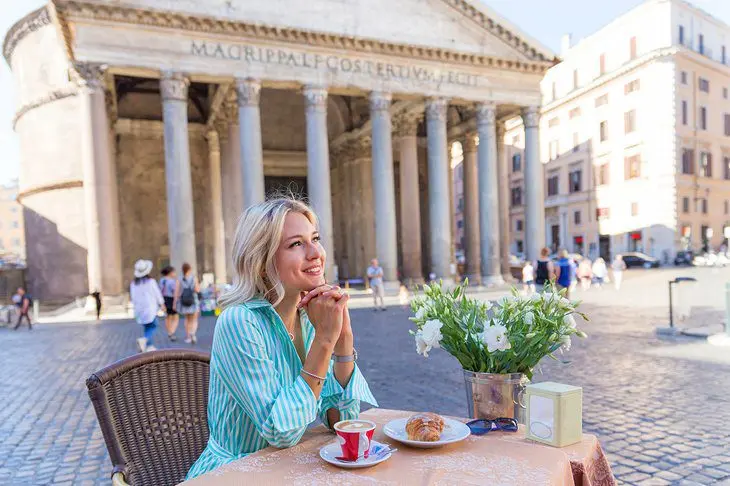
Osteria del Sostegno at Via delle Colonnelle 5 is a local-favorite, old-style trattoria with great atmosphere and exceptional roast lamb. Nearby but not as crowded as many others in this busy neighborhood, Ristorante Grano at Piazza Rondanini 53, is another local favorite, especially for its seafood. Taverna del Seminario, on Via del Seminario, serves pizza and heartier meals in traditional surroundings.
A good lunch choice for panini and pizza is Lost Food Factory, just beyond Osteria del Sostegno on Via della Maddalena. You’ll find vegetarian options here, too. Miscellanea, on Via della Palomabella, is a casual spot that also does takeout.
For gelato, look around the corner from the Pantheon on Via Degli Orfani 87 to find Venchi Cioccolato e Gelato.
Shopping near the Pantheon
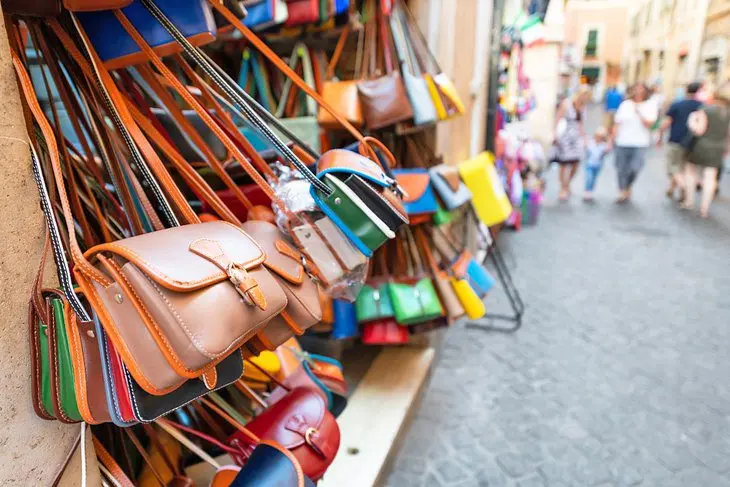
You’ll find the little streets near the Pantheon filled with small shops. Two are known for their exquisite paper goods: Cartoleria Pantheon dal 1910 on Via della Maddalena is filled with beautiful stationery, cards, and bound journals, while Il Papiro, on Via del Pantheon features beautiful marbled papers and a variety of notebooks, frames, and boxes covered in marbled paper.
You’ll find casual clothing and shoes at Replay, opposite the Pantheon at Via della Rotonda 24, and perfumes and fragrances at Campomarzio70 — Pantheon, also on Plaza della Rotonda. For beautifully handcrafted leather bags and accessories, look for Del Giudice Roma on Via della Stelletta 24, a studio/workshop owned by a family of leather artists for half a century.
More Related Articles on PlanetWare.com

What to See in Rome: For a look at the most important sites in the city, you’ll want to see our article on the top tourist attractions of Rome. When it comes to learning the history and details of visiting individual attractions, you’ll find more handy tips in our pages on visiting the Roman Forum and the treasures of the Vatican.

Where to Go near Rome: A number of fascinating attractions are easy day trips from Rome, including the beautiful gardens of Tivoli and the ancient port of Ostia Antica.
